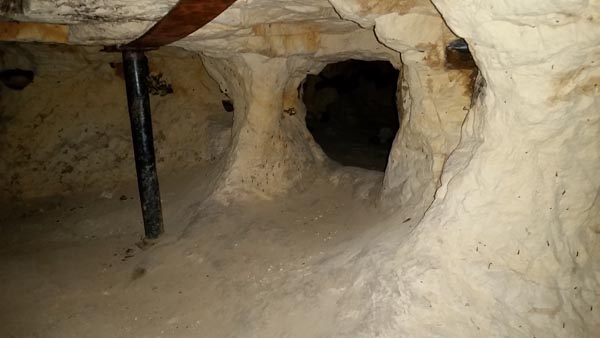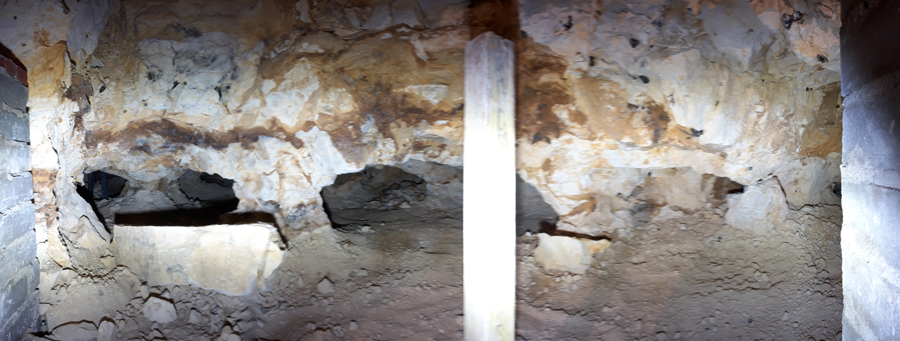Waarom wordt er bij de vuursteenmijn gewerkt?
| De prehistorische vuursteenmijn van Rijckholt is in de jaren 60 opgegraven door vrijwilligers van de Nederlandse Geologische Vereniging Afdeling Limburg onder leiding van de broers Werner en Sjeuf Felder onder archeologische begeleiding van Prof Waterbolk van de Universiteit Groningen. In de jaren 70 is de mijn geschikt gemaakt om met bezoekers ondergronds een kijkje te komen nemen naar de prehistorische mijngangen. Sindsdien worden excursies verzorgd naar de vuursteenmijn. | |||||||||||
| Nu, 45 jaar later, is de mijn aan een grote opknapbeurt toe. De stalen draagconstructies die in de jaren 70 geplaatst zijn, hebben een onderhoudsbeurt nodig. De elektrische installatie is aan een moderniseringsslag toe en de presentatie voor het publiek is ook verouderd. Omdat de mijn in het bos ligt en in de winter-helft van het jaar dicht is om de vleermuizen een overwintering te gunnen, zou een informatiecentrum in Rijckholt ook wenselijk zijn. | 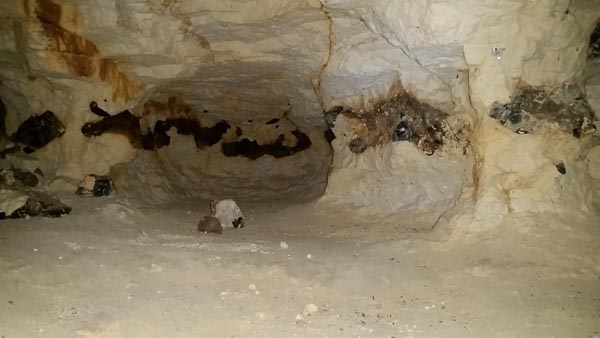 |
||||||||||
| In 2017 heeft Staatsbosbeheer het beheer en de exploitatie van de vuursteenmijn overgedragen aan de Stichting Ir. D.C. van Schaik. Wij hebben in 2019 verbeterpunten heel gedetailleerd in kaart gebracht en een plan uitgewerkt om de verbeteringen aan te pakken. In het plan staat dat we de verstevigingen een grote onderhoudsbeurt geven, dat we de informatiepanelen in de mijn gaan vernieuwen, dat met moderne technieken de mijn mooi uitgelicht gaat worden en dat in Rijckholt in het deel achter de ingekorte kerk een Informatiecentrum ingericht gaat worden. Daarnaast zijn enkele plekken in de prehistorische gangen toch wat instabiel waardoor achterliggende mooie delen niet meer veilig bereikbaar zijn. Daarom wordt op 4 plaatsen een nieuwe gang door de onveilige delen gemaakt om de mooie, onaangetaste, prehistorische gangen te ontsluiten. | |||||||||||
 |
Dit plan is heel positief ontvangen bij Staatsbosbeheer, bij provincie en gemeente en bij de Rijksdienst voor het Cultureel Erfgoed. Samen hebben we het plan uitgewerkt, specialisten er bij betrokken en alle mogelijke vergunningen geregeld. De Rijksdienst voor het Cultureel Erfgoed heeft voor de verbouwing een subsidie verleend op grond van het instandhouding monumentenzorg en Leader heeft een subsidie toegekend om de presentatie in de mijn te verbeteren en voor het inrichten van een infocentrum in het kerkje van Rijckholt. | ||||||||||
|
De Werkzaamheden in het kort:
Op deze speciale website zijn de vorderingen te volgen van de werkzaamheden. Klik hiervoor in het menu op "Nieuws", daat is per maand in een dagboek te volgen wat allemaal gebeurt bij de vuursteenmijn. |
|||||||||||
| De consolidatie is mogelijk gemaakt met een subsidie in het kader van het programma Instandhouding Archeologische Rijksmonumenten en gefinancieert door de Rijksdienst voor het Cultureel Erfgoed. |  |
||||||||||
| De herinrichting in de vuursteenmijn en het infocentrum zijn mogelijk gemaakt met een Leader subsidie. |  |
||||||||||
| Belangrijke medewerking was belangrijk van de gemeente Eijsden-Margraten, de provincie Limburg en Staatsbosbeheer |
|
||||||||||
| In 2021 is veel schade en vertraging opgetreden door de wateroverlast in Zuid Limburg. Het Nationaal Rampenfonds heeft ons daarin gecompenseerd zodat we het project toch conform plan hebben kunnen uitvoeren. Wij zijn het nationaal rampenfonds daar zeer dankbaar voor. | 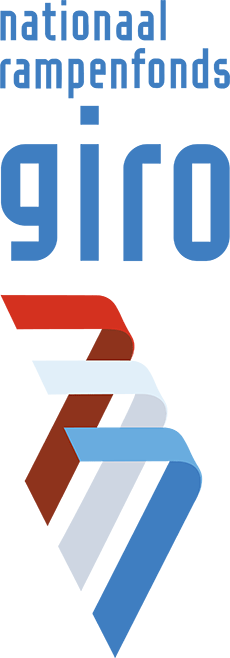 |
||||||||||
Een impressie van de vuursteenmijn van voor de werkzaamheden.
Foto's gemaakt door: Tycha Buekers, Joep Orbons |
|||||||||||
English summary.
Archaeological information
|
In the South-east of The Netherlands, cretacious limestone outcrops in river valleys. The limestone has many bands of flint in it. In prehistoric times, these band of flint were gathered and mined in a couple of dozen locations regionaly. One of the locations are the neolithic flint mines of Rijckholt, mined between 4000 BCE and 2750 BCE. The 12 hectare area has between 2000 and 4000 individual flint mines, up to 15 metres deep. After the neolithic times, the mines and the flint were forgotten. Photograph: One of the neolithic underground galleries |
 |
|
In 1881, Belgian archaeologists found the mines and did the first excavations. Photograph: The visitor tunnel with windows left and right to view the prehistoric galleries. |
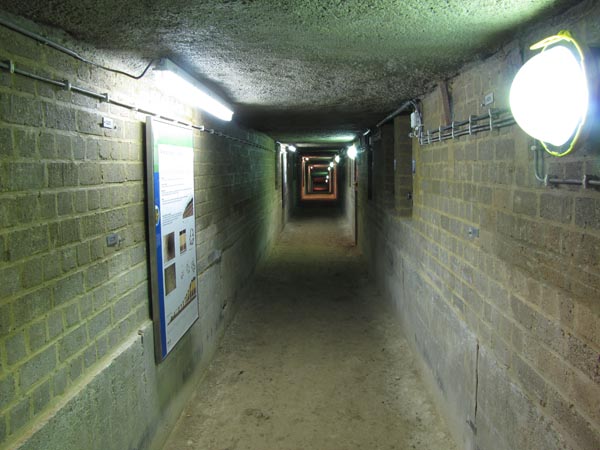 |
In 2017, the keeping and maintenance of the Rijckholt Flint mine was transfered to a volunteer association, the Stichting Ir. D.C. van Schaik, continueing the excursion and inviting research.
In 2019 we carried out an evaluation of the stability of the prehistoric galleries, resulting in a restauration plan for the mine to consolidate the archaeological monument and to improve and mondernise the information for the public visiting the mine.The plan was well recieved and fully subsidised by the Dutch Heritage Agency RCE. The improvement of the presentations will take place in the flint mine as well as in a new infocentre in the village of Rijckholt. This is financed through a Leader subsidy.
The planning in short:
- In 2021 the mine is being consolidated and 4 new tunnels will be made. In the village of Rijckholt, a visitor centre is being constructed in part of the church.
- In 2022 the public presentations in the mine are renewed and the visitor centre will be set up
- In 2023: Grand opening.
At the end of this page, the major highlights from the work are presented with pictures. So please scroll down to follow the workings.
The restauration plan
The map below gives information on the restauring plan. 
- Red: The prehistoric galleries behind the tunnel are walled up. Viewing holes will be made to check what the status is of the galleries behind the solid concrete walls.
- Green: Supports of the roof of the prehistoric galleries in need of maintenance.
- Blue: Shaft that need to be supported.
- Black: 4 new galleries to be made through areas of poor stability to reach area's of good stability and high scientific and landscape properties.
In the new galleries, the windows will be widened for a better view of the prehistoric galleries. The prehistoric galleries are 50-80 cm high, we don't want the public to crawl throught the fragile galeries with the prehistoric marks. The visitor tunnel (both the existing one as well as the new ones) will be 1.5 metres wide and 2 metres high so visitors can walk through them in a normal way. The architect made an artists impression. 
 |
 |
A 3D digital model of the flint mine and the visitor tunnel was made. The long tunnel with the light blue floor is the modern visitor tunnel with windows to the prehistoric galleries. The black dots halfway up the walls are flint nodules left in the limestone pilars, the flint in the galleries was mined. The brown zones are geological phenomenon, vertical karst sollution pipes where clay, gravel and sand work through into the limestone. The pipes that reach upwards are the prehistoric shafts the prehistoric men created to reach the flint layer up to 14 metres in depth. Since no light was used underground in those days, they could only mine a couple of metres with daylight streaming in through the shafts. New shaftfs are made roughly every 10 metres.
Click on the image for the existing situation to enter the 3D model and navigate the flint mine. Use the mouse to rotate left-right and up-down, the scrollwheel zooms, the ctrl key with mouse movements will pan the view. 
After the restauration, 4 new galleries are constructed. Click on the image below for the 3D model of the new situation. The 4 new galleries are clearly visible. 
The restauration of the mine is subsidised by the Dutch Cultural Heritage Agency RCE. The owner, the Dutch State forestry is closely involved in the works. Professional engineers, geologists, archaeologist, ecologists and construction workers carry out the work, all supported by volunteers from our Association.
The restauration took a lot of preparing because the prehistoric flint mine is a sceduled ancient monument, it is an underground mine where strict rules apply for working and it sits in a nature reserve. Thanks to the support of every body and all organisations involved, we managed to get the program going.
Visiting the flint mine
The visits to the flint mine still continue. A 80 metres long stretch of the visitortunnel is visitable with 21 windows into the prehistoric galleries where all kind of mining and archaeological features are visible. There are 7 guided tours a week during the July, August and September visitor season. The mine is closed from October 1st to April 1st to allow for hibernating bats.
The guided tours start at the large, free parking in Rijckholt. The tour is a 2 - 2.5 hours excursion from the village to the mine with an underground visit and back again. No lights are needed, no climbing or crawling. A normal fitness is needed for the walk. Take a warm sweater or coat because the mine is cold, even in summer. Groups are not larger than 10 persons. The regular Covid precautions are taken, 1.5 metre distance between groups. Children are welcome. Dogs on a leash are welcome. The excursion will be canceled in thunder weather and when the wind is stronger than windforce 7.
The guided tours are in Dutch, the guides can summarise the information en route to the mine. Send an email to Dit e-mailadres wordt beveiligd tegen spambots. JavaScript dient ingeschakeld te zijn om het te bekijken. for a special excursion with a guide in English, German or French.
Click at the image below to book your tickets for an excursion to the flint mine.
The progress of the restauration
April-May 2021
Archaeologist carry out an extensive survey of all the parts that are going to be affected by the construction work. |
 |
Some of the finds, a nealithic pick, an axe and measurement points from the 1960 excavation. These are also declared archaeological valuable.  |
 |
Surveying the mine with GPS above ground and with a total station underground  |
 |
Filming underground for a documentary about the restauration. |
Some parts are even filmed through an underground flying drone.  |
The electrical instalation had to be temporarily altered to allow for the new tunnels to be made, but maintain light and power for the construction workers. Our volunteer-electrical engineer helped out.  |
The archaeological work in the prehistoric galleries is carried out by profesional archaeologists. Since they are not familiar with the safety and dangers of working in the underground, our volunteers who are certified for working in these underground spaces support them making sure all the work takes place in a safe and secure way. Below two of our volunteers and one archaeologist, hard to tell who is who.  |
On May 20th we organised a studyday and invited a large number of profesional and amathor archaeologist to the mine and discuss about mining, extractions marks and visualisation of mining traces. Our volunteer group guided the visitors into the mines. We also arranged an extensive lunch for all to enjoy.  |
 |
 |
 |
A 3D laser survey was tried in part of the mine to 3D visualise the mine.  |
 |
Meetings between the owner, the heritage agency, the archaeologists, geologists, and our team take place one site, in the open, we discuss the plans and find sollutions for the situations encountered. These meetings take place every week.  |
A large group of our volunters have started to draw the plans for the visualisation in the mines and in the info centre. These meetings with flipboards and extensive discussions prepare for actual building in 2022. |
| Bats use the mines too for hibernating but also for swarming and mating in the authumn. To monitor the bat movements, a bat counter is installed in the gate by volunteer bat researcher Hans Weineich. |  |
June 2021 |
|
|
The construction starts. The old information panels are removed and the construction company bring in heavy equipment for underground work. |
 |
Parts from the cieling has a lot of prehistoric pickmarks. The block has to be removed and is carrefully broken loose from the ceiling and brought to the archaeological depot for preservation. |
A huge saw makes cuts through the modern concrete walls for us to reach the limestone to start tunneling.  |
The new tunnels nr 4 is opening up to the prehistoric galleries. A wide panoramic view is visible, just what we want the public to see in our future new tunnels, emerged into the prehistoric landscape.  |
|
While tunneling for the new tunnel nr 3, some beautiful geological phenomena are made visible.  |
 |
| One of our volunteers is an well experience flint knapper. He can make the best replicas of prehistoric tools like axes, arrowheads and knifes. He uses the flint that is mined in the new tunnels for flint knapping experimentations. |  |
An information panel is mounted to inform the passers by about the reason for the intrusive building materials in the lovely forest. There is QR code with a link tot this website.  |
The new tunnel 2 is opened and the tunneling starts. Two iron beams are installed to support the roof so the tunneling can progress safely. 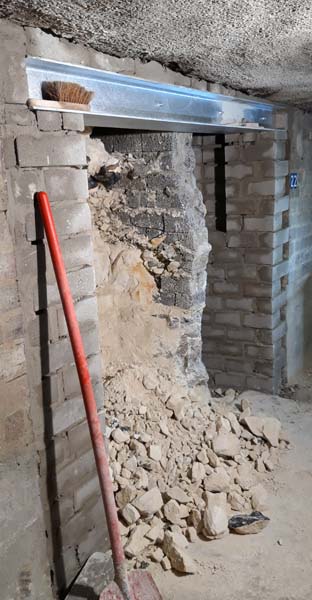 |
| Regional news and papers pick up the work taking place in the flint mine. The regional TV L1 braodcasted an interview with Fred Brounen from the State Heritage archaeologist and with Joep Orbons from the Flint Mine about the work. |  |
July 2021 |
|
| The rain is hampering the work. Record amounts of rain fall. The map to the right shows the rainfall in 24 hours. The flint mine is in the south in the purple zone with the most rain in years. The rain and the tractor movements, ruined the forest path. The path is restored for visitors to the forest so they can walk safely and also for the transport to and from the mine to keep moving.  |
 |
| In 2022 some new presentations will be installed in the mine. This includes new light. To experiment with some new ideas, we installed some lights in three half-open prehistoric shafts, giving the impression that the shaft is open to the surface and daylight is streaming in. This is the view the prehistoric men had while working in the mine, 6000 years ago. The power cable to the light looks like a cable used by the prehistoric men to enter the mine. We think the experiments with the lights are succesfull and will progress on this. 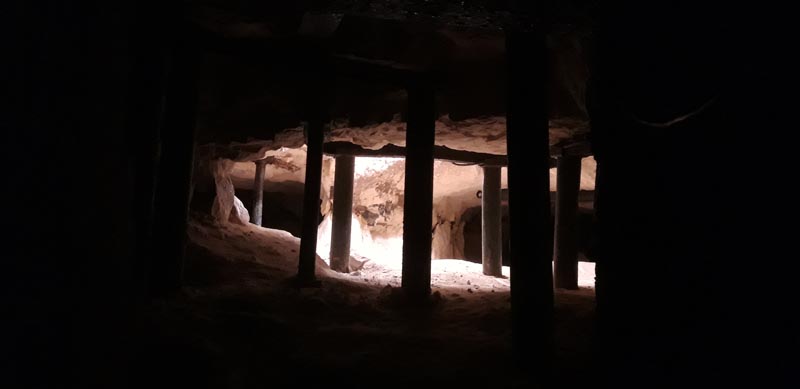 |
 |
| After nearly 6 metres of new tunnel nr 3, a breakthrought into the prehistoric galleries. After further widening, this will become an other panoramic open view into the prehistoric galleries. |  |
| The new tunnel nr 2 is progressing slowely. The stability of the limestone forces the construction workers to work slowly, safely and remove the loose bits in a controlled way. After one month, 3 metres new tunnel are made, 11 more metres to go. | 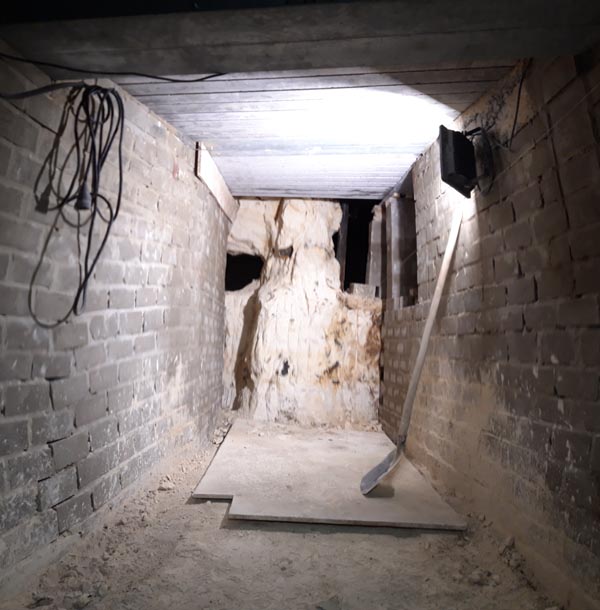 |
| The new tunnel 3 is progressing nicely. The left wall is now nearly finished and supporting the solid ceiling. The right wall has it final bend and then continues for some 2 metres, opening up a wide panoramic view into the prehistoric galleries. The first half of the week the new tunnel is hammered, the second half of the week, the side walls are constructed. These walls can then harden so the following week, new tunneling can take place. Hopefully next week a complete opening into the prehistoric galleries. |
 |
|
At the end of July, we have reached some good results. In tunnel number 3 the supporting walls are finished, the balcony with the panoramic view into the prehistoric galleries is also finished. The only things that needs to be done is to place the safety roof and to dress the walls. The panorama is stunning.
|
 |
| The new tunnel number 4 is also approaching its goal. The supporting walls are finished, the balcony is being made. Again here only the roof and the finishing of the walls is needed. |  |
|
Tunnel number 2 is slowely progressing. A geological sollution pipe is now safely walled in and progress can be made. In the picture to the right the safety roof can be seen as well as window number 2 in the left wall and the start of window number 3 in the right wall. We hold a weekly meeting with the construction company, archaeological regulators, architect, archaeological support and the owner. In the photograph below, from left to right Lucien Constructionworker from Mergelbouwsteen Kleijnen, Rene Haemers from the Van Schaikstichting, projectmanager and keeper of the flintmine, Fred Brounen, archaeologist from the Dutch Cultural Heritage Agency and Joey, construction worker from Mergelbouwsteen Kleijnen.
|
 |
August 2021 |
|
On August 3rd we invited two photographers specialised in underground photography to photograph the construction workers and take some photographs of the underground galleries.  |
 |
Tycha Buekers and Bert Beckers excel in proffesionalism, the phtographs are stunning. |
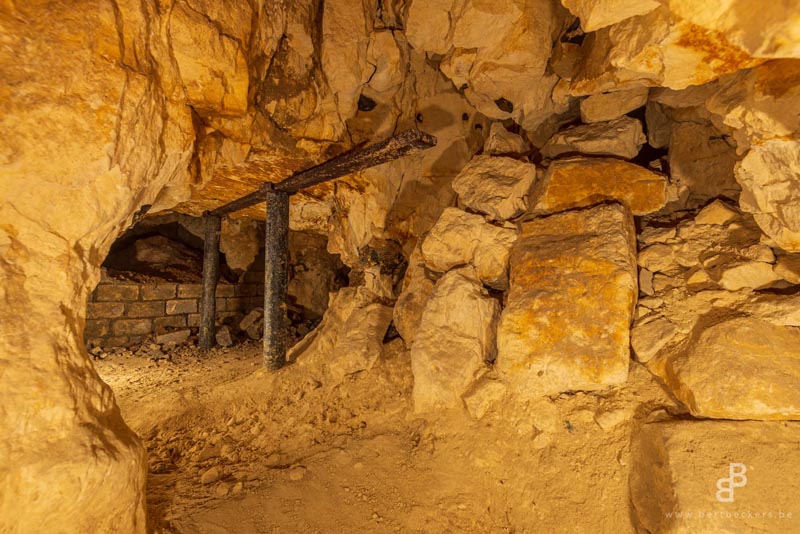 |
| Our team consisted of Tycha Buekers (Photographer), Bert Beckers (Photographer), Rene Haemers and Joep Orbons | |
 |
 |
Keep following this page for more progress.
Handige sites
Eigenaar van de vuursteenmijn: Staatsbosbeheer
Beheerder van de vuursteenmijn: https://vanschaikstichting.nl/
Websites met informatie over de vuursteenmijn
Wat gaan we doen in de vuursteenmijn en het infocentrum?
De werkzaamheden zijn in twee delen op te splitsen: Consolidatie en Presentatie.
Consolidatie
Voor de consolidatie in de vuursteenmijn worden een aantal zaken aangepakt. In onderstaande kaart van de vuursteenmijn zijn die locaties in kleuren weergegeven.

| In het detailkaartje hiernaast is te zien dat de rode kijkgaten in de muren van de lichtblauwe bezoekersgang gemaakt worden. Deze muren zijn in de jaren 70 dichtgemetseld en sluiten delen van de prehistorische gangen af. Destijds is niet vastgelegd waarom die prehistorische gangen met muren afgesloten zijn en niet meer betreedbaar zijn. Door zes kijkgaten te maken, kunnen we onderzoeken, eventueel met een camera, hoe de gangen in deze delen er bij liggen, wat hun staat is en of het mogelijk is, deze delen ook zichtbaar te maken. |  |
| De groen delen bevatten stalen ondersteuningen uit de jaren 70 die een onderhoudsbeurt nodig hebben, het betreft 11 locaties. Dit kan een eenvoudige verfbeurt zijn maar het kan ook zijn dat delen vervangen moeten worden of dat nieuwe draagconstructies bijgeplaatst moeten worden. |  |
| De blauwe cirkels zijn tien schachten die een onderhoudsbeurt nodig hebben. De meeste schachten zijn ondersteund maar in de jaren 60 zijn ook enkele schachten onvoldoende ondersteund of helemaal niet ondersteund. Om te voorkomen dat die schachten doorbreken, dienen afdoende ondersteuningen aangebracht te worden. |  |
|
Er zijn vier plaatsen waar een nieuwe zijgang gegraven gaat worden of waar een bestaande, korte, zijgang verlengd gaat worden. Dit wordt gedaan omdat de delen waar de gang komt minder stabiel zijn. Stabilisatiewerkzaamheden zouden zo ingrijpend zijn voor het ondergrondse landschap en de archeologie, dat het goedkoper, veiliger, mooier en efficienter is om een gewone, grote gang te graven die dwars door het instabiele deel gaat waar dan ook onderzoekers en bezoekers de achterliggende delen veilig kunnen bereiken. Juist die achterliggende delen zijn gaaf, hebben een prachtig ondergronds landschap en geven toegang tot nog on-opgegraven stukken vuursteenmijn. |
  |
Architectenbureau Leise heeft tekeningengemaakt van de nieuw gangen waarbij veel aandacht is uitgegaan naar de beleving van het prehistorische ondergrondse landschap. Er zijn grote ramen ontworpen die direct aan de prehistorische gangen liggen zodat de bezoeker vollop midden in de prehistorische gangen staat zonder te hoeven kruipen, gewoon, rechtop. Hieronder twee uitsnedes uit de architectentekening en een artists impression hoe de nieuwe bezoekersgangen er uit komen te zien.
 |
|
 |
 |
De prehistorische vuursteenmijn is een groot ondergronds complex van schachten en gangen waarvan een deel opgegraven is. Dit opgegraven deel is ingemeten en in een 3D visualisatie weergegeven. Hieronder staan twee verschillende 3-dimensionale visualisatie.
De eerste visualisatie is de bestaande situatie vóór de restauratie en uitbreiding. De technische ruimte is goed herkenbaar. De lange gang met lichtblauwe vloer is de bezoekersgang van waaruit de prehistorische galerijen bekeken kunnen worden. De bezoekersgang is 2 meter hoog maar de prehistorische gangen zijn heel laag. Duidelijk zijn de zwarte vuursteenknollen te zien die halverwege de mergelwand zitten. Deze vuursteenknollen zijn door de prehistorische mensen gewonnen. De bruine zones zijn zogenaamde aardpijpen waar grond, grind, zand en loss door zwakke plekken in de kalksteen naar onder dringt. Ook zijn de schachten goed herkenbaar die vanaf het oppervlak naar onder gegraven zijn door de prehistorische mens om deze vuursteen te ontginnen. Duidelijk is te zien dat de bezoekersgang maar een klein deel van de prehistorische gangen zichtbaar maakt.
Klik op onderstaande foto voor de 3D visualisatie. Dit werkt het beste op een bureaucomputer of tablet. Met de muis kan dan rondbewogen en ingezoomd worden.
In de tweede 3D visualiatie zijn vier nieuwe gangen weergegeven. Het zijn twee nieuwe gangen die ongeveer halverwege de bestaande bezoekersgang naar links en rechts gaan. Verder is op twee plaatsen een bestaande kleine zijgang verlengd. Die nieuwe zijgangen hebben veel bredere vensters en komen tot direct in de prehistorische gangen. Ze ontsluiten de mooiste gangen zodat de bezoeker na de restauratie midden in de prehistorie staat en de prehistorie met de neus aan kan raken, figuurlijk dan.
Klik op onderstaande afbeelding voor de visualisatie van de nieuwe situatie.
Dit zijn 3d plannen gemaakt op basis van het programma QGis. Deze plannen hebben verder geen software of plugins op de eigen computer of mobiel apparaat nodig om te functioneren.
Het kerkje in Rijckholt wordt in 2021 verbouwd door Eetcafe Riekelt. Aan het einde van het jaar is de verbouwing afgerond en komt een ruimte ter beschikking om als informatiecentrum in te gaan richten. In 2021 wordt de inrichting gepland zodat deze in 2022 uitgevoerd kan worden.
Presentatie
De vernieuwing van de presentatie wordt gesubsidieerd door Leader. Dit project start in april 2021 op en loopt tot april 2023. De planning is in grote lijn:
- 2021:
- Verzamel beelden, materialen en verhalen voor de vuursteenmijn en het informatiecentrum
- Ontwerp een nieuwe presentatie voor de vuursteenmijn met verlichting, infoborden, augmented reality
- Ontwerp de inrichting van het informatiecentrum in Rijckholt met panelen en digitale presentaties
- 2022:
- Richt de vuursteenmijn in met de informatiepanelen, verlichting en augmented reality opstellingen
- Richt het informatiecentrum in Rijckholt in met panelen en digitale presentatie en materialen.
- 2023:
- Officiele opening van de vuursteenmijn en het infocentrum









